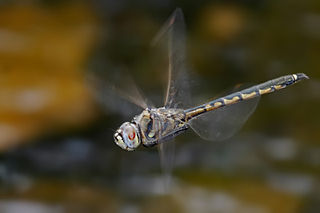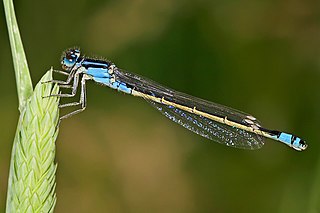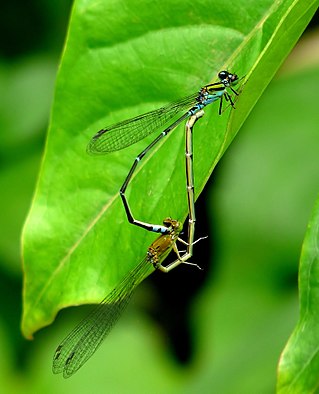
Coenagrionidae or are a family of damselflies, also known as pond damselfies, in the order Odonata and the suborder Zygoptera. The Zygoptera are the damselflies, which although less known than the dragonflies, are no less common. More than 1,300 species are in this family, making it the largest damselfly family. The family Coenagrionidae has six subfamilies: Agriocnemidinae, Argiinae, Coenagrioninae, Ischnurinae, Leptobasinae, and Pseudagrioninae.

The Platycnemididae are a family of damselflies. They are known commonly as white-legged damselflies. There are over 400 species native to the Old World. The family is divided into several subfamilies.

Ceriagrion is a genus of damselfly in the family Coenagrionidae. Species of Ceriagrion are small to medium size, generally brightly coloured damselflies. They are found across the Old World, Africa, Asia and Australia.

Gynacantha is a genus of dragonflies in the family Aeshnidae. The females have two prominent spines under the last abdominal segment. This gives the genus name and the common name two-spined darners; they are also known as duskhawkers.

Heliogomphus is a genus of dragonflies in the family Gomphidae.

Hemicordulia is a genus of dragonfly in family Corduliidae. It occurs in Africa, southern Asia, Australasia and Pacific Islands such as the Bonin Islands, Fiji and French Polynesia. Species of Hemicordulia are small to medium-sized dragonflies, coloured black or metallic, with yellow.

Indolestes is a genus of damselflies in the family Lestidae. Species of Indolestes can be medium-sized, dull coloured dragonflies. They are found from India through Asia, Australia and the Pacific.

Ischnura is a genus of damselflies known as forktails in the family Coenagrionidae. Forktails are distributed worldwide, including various oceanic islands. The males have a forked projection at the tip of the abdomen which gives the group their common name.

Macromidia is a genus of dragonfly in family Synthemistidae, which is earlier treated as a subfamily of Corduliidae. According to World Odonata List, this genera is best considered incertae sedis. It contains the following species:

Onychogomphus is a genus of dragonflies in the family Gomphidae. They are commonly known as pincertails.

Platycnemis is a genus of damselfly in the family Platycnemididae.

Pseudagrion is the largest genus of damselfly in the family Coenagrionidae, with over 140 species. Its range includes most of Africa, much of Asia, and Australia. Africa holds most of the diversity with almost 100 species. It has occupied most of the freshwater habitats in its range, and dominates damselfly communities in habitats as different as desert pools, equatorial rainforests and montane streams.

Rhinocypha is a genus of damselflies in the family Chlorocyphidae.

Teinobasis is a genus of damselflies in the family Coenagrionidae. Species occur in south-eastern Asia, Indonesia, Solomon Islands and Micronesia; one species, Teinobasis rufithorax, is found in Australia.

Zygonyx is a genus of dragonflies in the family Libellulidae. They are commonly known as cascaders because of their preference for living beside waterfalls and flying through the spray. They lay their eggs in wet dangling roots.

The Protoneuridae are a family of damselflies. Most species are commonly known as threadtails, while others are commonly known as bambootails.

The Synthemistidae are the family of dragonflies commonly known as tigertails, or sometimes called southern emeralds. This family is sometimes treated as a subfamily of Corduliidae. This is an ancient dragonfly family, with some species occurring in Australia and New Guinea. Most species are small in size and have narrow abdomens. Their nymphs are bottom dwellers, and resist droughts by burying themselves very deeply. Synthemistid dragonflies frequently prefer marshy areas, as well as fast-flowing streams. The family Synthemistidae is sometimes called Synthemidae.
Philoganga is a genus of damselflies, the only genus in the family Philogangidae.

Zygonyx iris, the emerald cascader or iridescent stream glider, is a species of dragonfly in the family Libellulidae. It is widespread in many Asian countries.


















